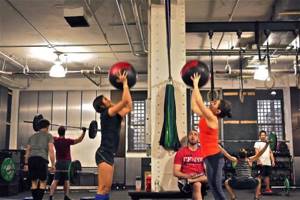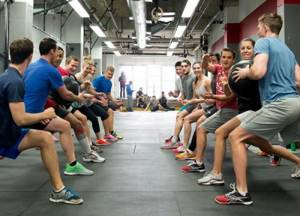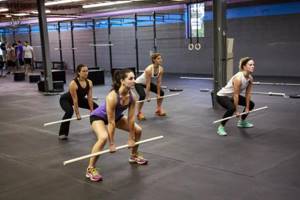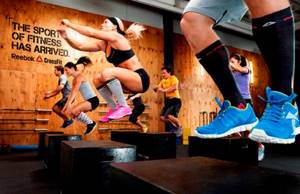The harm of CrossFit. The benefits and harms of CrossFit.
The CrossFit training system, like any other sports method, has its pros and cons.
First of all, we should talk about the health benefits of CrossFit - they are huge and multifaceted. Specific classes based on programs created by a former gymnast train the respiratory system. Since CrossFit develops endurance, it means that at the same time it strengthens the immune system and activates metabolism.
. Therefore, hair and nails will gain strength, skin - elasticity, joints - mobility. In combination with a properly selected diet, CrossFit can rid the female epidermis of the hated “Orange Peel.”
Separately, it is worth emphasizing the positive effect of CrossFit for weight loss. Being a high-intensity complex training, the system promotes colossal calorie burning, as mentioned above. This effect also occurs due to the involvement of different muscle groups at the same time. Maintaining a high heart rate gives the body the opportunity to expend energy at a faster rate than what happens in conditions, for example, of training on a simulator - a favorite women's means for losing weight.
Another special feature of CrossFit is that the process of burning calories and growing muscle mass does not occur only during training, but also during the rest period. And all this in a maximum of an hour a day, since specific workouts do not differ in duration. The advantages of CrossFit as a type of sports activity is also the absence of the need for concomitant intake of steroid hormones.
The disadvantages of such training, alas, are much more significant.
Although in most sources of information you can find statements about the benefits of CrossFit for the cardiovascular system, the opinions of experts on this issue differ. Some people really believe that when doing CrossFit, the heart muscle is strengthened, but an increasing number of them refutes this fact, insisting on the opposite: training according to the Glassman system can easily provoke the development of coronary heart disease, and subsequently myocardial hypertrophy. Isn’t this fertile ground for a heart attack to occur on one “Wonderful” day?
An equally terrible consequence of CrossFit training is the possibility of developing a disease called “Rhabdomyolysis.” Its essence is that one of the torn muscle fibers enters the bloodstream, and as a result, kidney damage occurs.
Thirdly, a high degree of stress often causes malfunctions in the body in the form of joint pain, loss of strength, and nausea. These signs become a signal that CrossFit training is not suitable for you, or at least you should slow down its pace. In any case, get a medical examination. And it will be better if you do this before starting CrossFit, and not after the occurrence of alarming symptoms.
Competent trainers
The more gyms I tried, the more I appreciated the truly experienced trainers. Some (not all) of them can see what the athlete is doing wrong. Even fewer coaches are able to not only see what exactly the athlete is doing wrong, but also understand why this is happening and how to fix it.
A good coach is one who knows you - your strengths, your weaknesses, your injuries, if any, the features of your technique, knows how to assess your intensity and how fatigue affects you. Such personal relationships may be difficult to build in a large hall or a hall that moves very quickly. If an athlete has not established such a relationship with a coach, he should continue his search in an attempt to achieve better results and minimize the risk of injury.
How do you become a CrossFit Level 1 Trainer? You attend a two-day seminar and take an exam in the form of a test. That's all. After this, a person can open his own CrossFit gym and train people. I took this course. As a sports medicine professor and CrossFitter, I can't say whether this course is sufficient or not simply because I don't know what the course is supposed to teach.
Some of the material was really smart. And part of it is typical Krossftire water. Be that as it may, I want to say that level 1 trainers vary greatly both in experience and skills, in level of knowledge and training. And not only your progress, but also the risk of injury depends on your coach.
CrossFit benefits and harms for women. Harm to health
Like any other active sport, crossfit also has its negative sides. In what case will CrossFit be harmful for girls? Let’s figure it out.
- With an uncontrolled training regimen, CrossFit puts a serious strain on the cardiovascular system. Still would! The average pulse of work during training for experienced athletes varies from 130 to 160 beats per minute, and in some places it can reach 180. Monitor your work during training and listen to the coach - you will be happy!
- Due to anatomical features, women suffer from osteoporosis much more often than men - 3-5 times! Pubmed published (source article on the US National Library of Medicine National Institutes of Health dated November 22, 2013) an interesting scientific study: it turns out that crossfitters are more likely than other athletes to get problems with the musculoskeletal system. And not so long ago it became known that extreme exercise gradually leads to a decrease in bone mass, which is the root cause of the development of osteoporosis.
- Unlike gym classes and banal cardio, CrossFit is not recommended for pregnant women and new mothers during lactation. Such high-intensity training can lead to overwork of an unrecovered female body and cause a lack of milk. Athletes often complain that after training, children refuse to breastfeed because the taste of milk becomes less pleasant. The reason is lactic acid, which the mother’s body secretes during exercise. If you do decide to do CrossFit after pregnancy, don't forget to stabilize your shoulder blades, wrists, and torso!
Energy continuum
Depending on the intensity and duration of effort, energy production occurs either without the participation of oxygen or with its participation. The breakdown of glucose, which is the main fuel during exercise, continues as long as the exercise itself lasts, and its intensity is low enough that it requires more and more oxygen. People often talk about anaerobic (without oxygen) or aerobic (with oxygen) glycolysis, but still we are talking more about a continuum, the dominance of which depends on the type of effort. The human body is essentially a hybrid motor driven by many energy systems, and the predominance of one or another depends on the load.
The CrossFit context is interesting in that load oscillates between the aerobic and anaerobic systems, acting through the addition of intensity throughout the workout.
And it is in this specific context that we most often hear about lactates.
The harm of CrossFit for girls. Fashion and power
So, what is CrossFit - this is an intensive complex training, collected from different areas: running, gymnastics, powerlifting, plyometrics, etc. Both aerobic and strength exercises (both with your own weight and with equipment) - all together. The system is based on the method of interval and circuit training. That is, fast speed alternates with calmer speed, and the set of exercises is repeated in a circle.
CrossFit was originally created to develop overall endurance and power. Such a killer full body workout. Then more people started coming to it for “side” effects. Girls are attracted to such workouts as an opportunity for healthy weight loss, while guys build muscle mass.
And that’s why more and more fitness centers and martial arts sections are including crossfit in their program. Even many law enforcement agencies, fire departments, and police departments train their employees (both men and women) using this system.
However, many still have questions and doubts. Especially for girls. Still, the load is quite large, working with additional weight. Doesn't this harm girls? Are there any risks?
Therefore, I propose to take a closer look at the benefits and harms of CrossFit.
Intensity calculation
One of the features of cross-training at the start of working with large groups is the collective prescription of the load. In such cases, TD offers the same number of repetitions for everyone and a certain weight of the barbell (if necessary, differentiated for men and women, as well as for competition participants). It is clear that the muscle profiles of group members are different even within the same gender or level. Thus, some athletes can easily achieve 70% of their maximum and up to 15 repetitions in a row, while others, with perhaps a higher maximum, may “break” at 10 repetitions.
Another parameter is technology. Due to it, some athletes spend their energy more economically than others, so their workload needs to be adjusted so that they progress on a par with debutants. The last thing to consider is body weight, which significantly affects maximal strength levels and also increases the load in some exercises. Thus, the severity of squats with a barbell of 100 kg consists not only in the weight installed on the barbell. Here you should add the weight of the person doing the exercise, which sometimes equals doubling the weight. It becomes obvious that the load for an athlete weighing 60 kg and for one who weighs 120 cannot be set in the same way. This applies even more to pull-ups. Let's take the example of a beginner weighing 90 kg: he should begin his training with a supermaximal load! It is clear that the simple indication “10 pull-ups for everyone” is absolutely inappropriate here.
What this all means in practice is that if you give a group a TD that includes 10 reps of 100kg squats followed by 20 pull-ups, as many times as possible in 5 minutes, the workout will be different for everyone.
This is why cross training offers more adaptive alternatives:
- We will often talk about "max for X repetitions." It's simply about the maximum load you can handle X number of times. Example: max for 5 is the load you can handle 5 times, failing on the 6th.
- Sometimes we will not specify the workload, leaving it up to you to choose the most appropriate option so that you can complete the TD. Feel free to adjust the load during the lesson to suit yourself - if it is too difficult or too easy.
- Of course, the technical adjustments and exercise-facilitating options offered within the accepted framework of cross-training remain a powerful tool for individual load planning. Therefore, there can be no question of abandoning this approach.
CrossFit benefits and harms. What is crossfit
CrossFit is a special training system that is aimed at simultaneously developing several physical qualities: strength, endurance, flexibility, speed. The main feature of this technique is that there is no narrow focus, so thanks to this scheme you will be able to prove yourself not only in power sports, but also in those that involve speed and endurance. This technique includes both elements of classical fitness, bodybuilding, and gymnastics and athletics. Such diversity helps to keep up with everything. This is the main benefit of CrossFit.

But you won’t be able to be the best weightlifter or gymnast, since your performance will be average, but in several sports. By the way, every day the training will take place according to a new plan. All classes are held in a group. They take approximately 50 minutes to an hour. Everyone practices at the same time, and the coach monitors everyone.
During the exercises, dynamic load is provided. For example, you will need to jump rope, do quick squats, push-ups, and lunges. Exercises are also used to help warm up and stretch the muscles. In addition, strength exercises are performed. Snatches, chest thrusts, squats, and deadlifts are suitable.
The benefit of CrossFit is that in a short period of time you can get your body in order: get rid of excess weight, build muscles, improve their tone. Anyone can practice this method. But the intensity of the exercises, the permissible weight and the speed of execution vary depending on the person’s parameters.
This technique is perfect for beginners. If a person has never been involved in sports regularly, then this option is ideal to “get involved.” The main thing is to choose a competent trainer who will monitor the correct execution so that the person does not get injured.
This technique is also suitable for fitness fans. There is a group of people who prefer to exercise every day. The CrossFit training plan is basically structured so that training will take place every day. The ideal option is 3 days with classes, and then one day for rest. But there are people who cannot live without training, so they sometimes train not once, but twice a day.
Often in CrossFit it is important to perform the entire volume in a short period of time, and for this you will have to work 100% without rest. But it’s better not to let it get to the point of overtraining. We must not forget about rest.

CrossFit is also suitable for former athletes. They are used to the spirit of competition, and this is precisely what is present in such intense group training. This technique is ideal for those people who want to get their body in order in a short period of time.
Basics of CrossFit Training
Source: “Cross-training”
Author:
instructor O.B. Derval, 2021
The main advantage of CrossFit
- this is its main drawback.
The appeal of most people to it is largely due to the variety of programs offered. But by initiating a new trend - unknown and innovative from many points of view, with different levels of load - “Training of the Day”
thereby creates space for various and often counterproductive improvisations.
While the most established franchises call for gradual progress and pragmatic organization, some trainers, excited by variety, personal inspiration, and sometimes considerations of hourly profitability, go too far in the content and variability of classes. Diversity, of course, is necessary and possible, but you should not do whatever you want, however you want, and especially whenever you want. And the main thing that CrossFit sometimes lacks is methodology
.
CrossFit is harmful to the heart. The effects of CrossFit on the heart
Now it’s worth figuring out whether CrossFit is harmful to the heart - how high-intensity training affects its functioning. There are 2 diametrically opposed opinions:
- Yes, CrossFit kills your heart.
- It only hurts if you approach training incorrectly.
Let's look at both - listen to what experts, doctors and famous athletes say.
Opinion "for"
The key reasoned argument in favor of the opinion that CrossFit is harmful to the heart is the study of Professor V.N. Seluyanov “The heart is not a machine.” (You can read the study here - take a look).
The work talks about harm to the heart during high-intensity work of professional skiers and runners. Namely, about the inevitability of pathological consequences as a result of regular long-term high-intensity training in a pulse zone above 180 beats/min.
Regular and long-term over 180! Read - section 5 is about this, and it is relatively short.
Opinion "against"
The opinion of athletes who believe that the impact of CrossFit on the heart is only positive. The main arguments can be summarized as follows:
- It is almost impossible to work regularly and for a long time in such a pulse zone.
- If you approach your training wisely and distribute the load according to your level of training and other input factors, then CrossFit and the heart will live in symbiosis for a long, long time.
On
Working in the correct heart rate zone
Professional athletes say that it is imperative to train your heart. And CrossFit will not be an obstacle to this if you adhere to certain rules. The most important criterion here is heart rate control during training.
If you are not a professional CrossFit athlete or a competitive athlete, for example, then the following guidelines will be helpful for you to take a healthy approach to training:
- The average working pulse should not exceed 150 beats/min (for beginners - 130 beats/min)
- Watch your diet and daily routine - get enough sleep
- Taking adequate time to recover from CrossFit workouts is essential for heart health.
Regarding the “one-time approach”
The 2010s saw an intensification of debate pitting the "single set" approach versus the "multiple set" approach to exercise. Some researchers and trainers - apparently in search of sensations - have actively discussed the seductive idea that one set performed "to failure" (the point at which you can no longer continue the exercise) is only slightly less effective than several, and that this the gap does not justify the use of multiple approaches (proponents of the “single approach” report only a 3% improvement in results with multiple approaches).
These theories have found an echo in cross-training, where long burnout sets and short workouts are especially popular.
And while much of the research has since found this paradigm untenable, here are some arguments to finally convince you that four is better than one.
- Who wouldn't want a 3% improvement in their results?
- The increase in muscle mass occurs in tired fibers due to maximum muscle tension. However, the causes of muscle saturation are different, and a single approach to exercise can be stopped for reasons other than complete local muscle saturation (CNS fatigue, psychological fatigue, blood acidity, depletion of energy reserves and especially lack of technical skill). In other words, the “to failure” approach, while showing good efficiency, cannot be used exclusively. In order for it to work it needs to be combined with other methods. Maximum loads should be repeated from set to set whenever possible, illustrating the concept of “repeated single set”
or “repeated single set” for cross-training techniques.
Harm from CrossFit. Disadvantages and harm of CrossFit
Functional training, along with its enormous advantages, also has its disadvantages.
SPRAY
Crossfit combines several completely different sports, from powerlifting to gymnastics. This means that if you engage in all these sports at once, as required by the principles of CrossFit training, progress in each of them will be minimal.
POOR MUSCLE GROWTH
Compared to any other strength sport, CrossFit has a very high level of energy expenditure. And muscle growth occurs only against the backdrop of a calorie surplus. Therefore, you should not hope for a significant increase in muscle volume by performing energy-intensive CrossFit complexes.
HIGH HEALTH RISK
If you use only CrossFit workouts for beginners, including the simplest movements, like the burpee, you won’t get serious injuries. But the more complex CrossFit exercises an athlete includes in his program, the higher the risk becomes.
- Lack of oxygen. Crossfit workouts can cause oxygen deprivation. This process is often accompanied by attacks of nausea and vomiting. CrossFitters call this "Pukey the Clown" (puking clown).
- Rhabdomyolysis. Doctors diagnose many seriously involved athletes with rhabdomyolysis, a disease that causes kidney failure. Rhabdomyolysis, or “Uncle Rhabdo” as it is called, occurs when skeletal muscle breaks down and muscle cell breakdown products enter the bloodstream. The main cause of this disease is sudden explosive movements with heavy weights.
- Joints. During CrossFit training, the musculoskeletal system is especially stressed. Joints, ligaments, tendons are at high risk.
- CNS. The desire to complete a WOD complex despite extreme fatigue significantly overstrains the body, forcing the nervous system to work to the brink of its limits.
- Heart. The worst thing is the heart. CrossFit classes conducted indoors, and even in an excessively warm room, contribute to a sharp increase in the load on the cardiovascular system. Such physical activity often leads to myocardial hypertrophy.
Content
- 1 CrossFit
- 2 Basics of crossfit training
- 3 Fundamental principles of CrossFit training 3.1 Principle number I: gradualism
- 3.2 Principle number 2: continuity
- 3.3 Principle number 3: diversity
- 3.4 Principle number 4: rotation
- 3.5 Principle number 5: load-recovery pair
- 4.1 Energy continuum
- 5.1 Rule number 1: prioritize work
Crossfit and pressure. What is CrossFit?
CrossFit is a training system aimed at simultaneously developing many physical qualities (strength, speed, endurance, flexibility, etc.). The main feature of CrossFit is the lack of narrow specialization - you can improve your physical performance both in strength sports and in those that require endurance and speed. CrossFit training includes both elements of “traditional” fitness and bodybuilding, as well as weightlifting, athletics, and gymnastics. It is the wide variety of CrossFit exercises that will help you succeed in “everything at once.”
However, this kind of training will not make you a better weightlifter, better gymnast or sprinter. But you will definitely learn to run faster than the average muscleman, while having more muscle mass than a competitive sprinter.
Definition from the official crossfit.com website:
CrossFit is a strength and endurance training program designed to train police officers, firefighters, military personnel, fighters, and professional athletes around the world.
The specialization of CrossFit is the absence of specialization. The skills acquired through CrossFit will be useful in combat, on a hike, and when playing any kind of sport. It is more useful for life to have “average” abilities in different sports than to be an expert in one of them.
According to the CrossFit ideology, a person's athletic training is only as good as their endurance (both strength and cardiovascular), strength, flexibility, power, speed, agility, balance, coordination.
CrossFit training is different in that every day you work on a new program. Moreover, each of them will be aimed at developing different physical abilities. This is how CrossFit allows you to build a body that can do anything.
Extensive capacity and ability to reproduce repeatedly
Schoffen and Ober in 2007 put forward an important concept - the concept of reproducibility. Up to this point, energy systems were viewed as a machine producing, on the one hand, power (the maximum intensity produced during an effort in a given system), and on the other hand, productivity (the time of exhaustion of the used system and its gradual abandonment in favor of the power of the next system ). It is this second point that the authors call “extensive ability”
. They contrast this with the ability to repeatedly reproduce high-intensity efforts within the same system. That's why we talk about strength endurance as a major cross-training specific need.
What is the meaning of CrossFit? What is CrossFit? Its pros and cons
Probably, many of the readers have heard about this type of fitness as CrossFit. Let's figure out what it means and why people around the world choose these particular workouts.
What is CrossFit? It is a training philosophy that trains people of various shapes and sizes to improve their physical well-being and cardiovascular health.
What is CrossFit? This is a program designed to optimize your physical skills: strength, endurance, cardiovascular endurance, flexibility, agility, speed, balance, coordination and accuracy.
What is CrossFit? This is a constant variety of functional movements performed at high intensity.
Changing your workout routine frequently will not allow your body to adapt to the exercise. And besides, routine is the enemy.
Functional movements are when you carry large loads, long distances, in a short period of time. All this contributes to the development of lean muscle mass and the reduction of fat deposits. These skills will help you in everyday life.

Finally, a high intensity component is necessary to achieve quick results. High intensity is defined as a large number of movements performed over a short period of time. The workouts are scaled so that each person has the opportunity to train at their own intensity level, regardless of their current fitness level. Over time the intensity will increase. This is the variable that will give you results.
CrossFit workouts use body movements (pull-ups, push-ups, squats, box jumps, jumping rope, etc.), elements of weightlifting (weights, barbells, balls, sandbags, etc.) and conditioning (running, rowing, cycling, etc.). And all this happens in different combinations. Such training is a real challenge to your capabilities.
Pros and cons of CrossFit

1. The CrossFit philosophy operates as a community that offers more than just a fitness class. Targeted training, nutrition, competition, motivation, camaraderie - all this will help you stick to your goals.
2. CrossFit gyms are friendly places. People say hello and communicate with each other, and this is much more pleasant than training without any human contact. You will meet interesting people and make new acquaintances.
3. Another advantage of CrossFit is competition. It's amazing how many times you will overcome yourself when surrounded by other people simultaneously applauding and competing with you.
4. All CrossFit training is supervised by a trainer to ensure proper form, modifications and encouragement. A coach can be your nutrition advisor, friend, and biggest cheerleader.
5. The successes that you will definitely achieve as a result of training will surprise you. CrossFit will show you what you're made of. These trainings will push you to cross many psychological barriers.
7. We all know that physical activity in any form gives you energy. Now imagine that this energy is combined with the fact that every time you surprise and overcome yourself, which certainly causes a feeling of pride and satisfaction. Plus you make new friends and communicate with interesting people.
8. CrossFit makes you happy. It certainly sounds strange and seems implausible, because from the outside it looks like “hell”. During training, you sweat, overcome yourself, but still want more. Don't believe me? Try it yourself!
Cons of CrossFit

1. CrossFit has come under a lot of criticism, mainly because the sport's fanaticism is perceived as a religion. CrossFit supporters form their own communities, which are somewhat closed. CrossFit is actually very addictive. Once you try it, you want to come back again and again.
2. Lack of consistency. To an outside observer, the lack of periodization, logical planning and organization of training seems strange.
3. A bad coach can cause problems. You do complex movements with heavy weights. They must be performed correctly, otherwise injuries cannot be avoided. Therefore, choose a good trainer who can properly control the process.

What muscle groups does CrossFit train?
CrossFit relies on the development of all muscle groups. Basic multi-joint exercises, both with your own body weight and with weights, are of great importance. Let's look at the main features in the CrossFit approach to developing the muscular system.
Lack of specialization.
CrossFit does not focus on the development of any one ability and the associated group of muscles and body systems, as is traditional for other sports. In fact, of course, athletes of all sports must develop all systems of the body, since the body is a single whole, the lag of some systems will inhibit the development of others. Therefore, for example, jumpers not only jump, but also run, swim, squat with a barbell, etc. But the emphasis in training is still on performing certain exercises and developing one skill. In CrossFit it’s different. CrossFit's original goal is to increase a person's overall fitness level, so avoiding specialization is key. And it makes CrossFit extremely flexible, suitable for use in training soldiers, police officers, firefighters, athletes of any kind of sports, and in general for the physical development of any person, regardless of his age and career guidance.
Emphasis on functional movements.
Functional movements are traditionally considered to be those necessary for a person to perform those tasks that occur in real life: lifting and carrying heavy objects, moving massive objects, jumping over obstacles, running, etc. In this case, the emphasis is on the imaginary past of our distant ancestors - hunters, fishermen, gatherers, etc. This implies the refusal of isolating exercises for individual muscle groups. For example, in CrossFit there is practically no lifting of barbells for biceps, or work on machines that work certain muscles. But the CrossFit arsenal includes multi-joint exercises: with free weights and body weight, aerobic types of exercise, exercises on gymnastic apparatus. Moreover, the exercises are constantly changing to provide the body with maximum opportunities for development.
High intensity circuit training.
In this case, the exercises are performed without rest, or with minimal rest. This allows you to train the entire body, developing it in all directions, and achieve success in the shortest possible time. On the other hand, there is some danger in this - a not very experienced athlete can easily exceed the loads allowed at his level of training and get injured or cause other harm to his health. Therefore, CrossFit is very demanding in terms of warming up and preparing for training, and also requires (in the first stages) the participation of an experienced trainer who will ensure smooth gradual development and increase in the level of preparedness, helping to adjust the training program and other aspects.
Each workout usually includes exercises for all major muscle groups. The split system that is usual for strength training is not used here - leg day, arm day, etc.
CrossFit for beginners.
Today it is almost impossible to talk about modern trends in fitness without touching on the topic of CrossFit. This high-intensity training program based on constantly changing functional exercises is now extremely popular, and it doesn’t seem to be going away.
“The great thing about CrossFit is that it’s for everyone. Former football players, ballerinas, and elderly people come to us,” says Nick Lobotsky, a level 1 coach from New York. And for good reason. After all, a CrossFit workout or WOD (workout of the day) is built in accordance with a person’s individual physical capabilities. In this article we will tell you how to start doing CrossFit even at home.
In that

Whatever your first workout of the day is (whether it involves bodyweight or machine exercises), you shouldn't be afraid of it. You need to challenge yourself, and the following workout programs will help you do this without exhausting you. But before we look at training programs for beginners, let's get acquainted with the terms used in CrossFit.
- – a specialized hall for crossfit classes.
- WOD (from the English Workout Of the Day) is a workout of the day, which is set by your trainer/boxing, and usually lasts about 20 minutes. The list of such workouts is constantly growing, and each of them has its own name.
- AMRAP (from the English “As Many Reps/Rounds As Possible”), which means “as many repetitions/rounds as possible.” This refers to timed training in which you must complete as many rounds as possible.
- For time (for a while) - this means that you must complete the established exercises as quickly as possible.
- The result is the total number of repetitions/rounds completed during the workout. If you finish a round but don't complete the set number of reps, then you add extra reps (e.g. 8R+12 means you have to complete 8 rounds and do 12 reps on the 9th when time runs out).
- Rx means that the workout was completed completely as prescribed in the task, that is, without changes. Written after the results. For example, 7R + 16 Rx.
- CrossFit Games - competitions of the best athletes, during which the “Fittest Man in the World” or “Fittest Woman in the World” is revealed (current cup holders: 4-time winner Rich Froning and Camille Leblanc-Bazinet).
Injuries
When assessing the risk of injury in a particular sport, we look at epidemiological data supplied by schools, hospitals and physical development centers. In the case of CrossFit, there has only been one small study done on injury risk.
When Cardiff University in Wales conducted an orthopedic study on the incidence of injuries during CrossFit training, they found a figure of 3.1 injuries for every 1,000 hours of training. Their conclusion was: “The risk of injury from CrossFit is approximately equal to the reported risk in the literature for people involved in weightlifting, powerlifting, or gymnastics.”
With a rate of 3.1 injuries per 1,000 hours of exercise, injuries from CrossFit training are significantly lower than those associated with contact sports, track and field, or the most traumatic sport, football. Thus, it turns out that CrossFit is not nearly as dangerous as the uninitiated person imagines. And then the question arises: “If CrossFit is really as dangerous as many people believe, where are all the dead bodies?”
How to track your heart rate during exercise
First measure the frequency in your quiet state. Then go around the circle and measure again. The frequency should not exceed 70% of the maximum.
The maximum is easy to calculate: it is 220 minus your age.
A minute's rest should bring your heart rate down to the initial plus 20%. If this does not happen, rest some more. It is convenient to use a fitness bracelet to monitor your heartbeat
One of my friends neglected this rule, took up training too eagerly, and as a result, he did not get beautiful muscle definition, but... heart problems. Or rather, the problems probably existed earlier. But his heart began to worry just when the man, who had not previously exercised, suddenly began to train intensively, without giving himself enough time to rest and recover. Naturally, the doctor prohibited such training, even in “light” mode.










